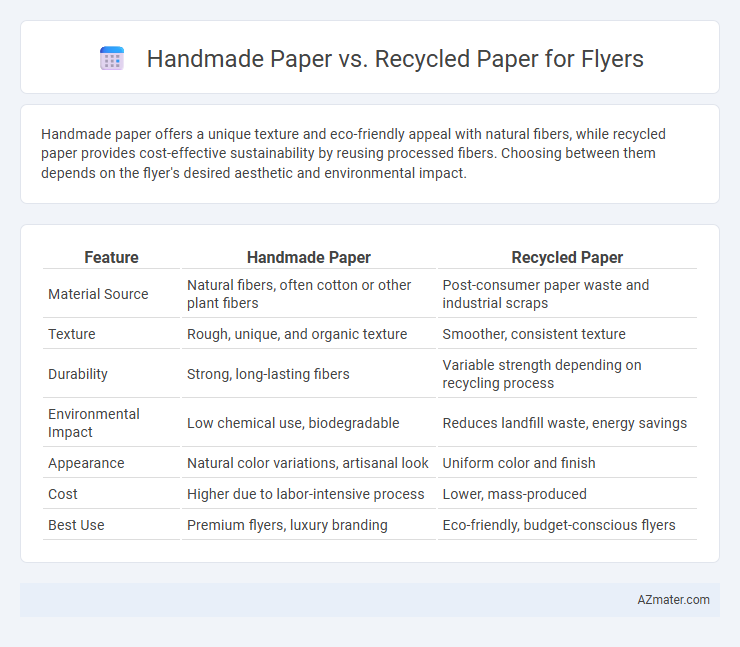Handmade paper offers a unique texture and eco-friendly appeal with natural fibers, while recycled paper provides cost-effective sustainability by reusing processed fibers. Choosing between them depends on the flyer's desired aesthetic and environmental impact.
Table of Comparison
| Feature | Handmade Paper | Recycled Paper |
|---|---|---|
| Material Source | Natural fibers, often cotton or other plant fibers | Post-consumer paper waste and industrial scraps |
| Texture | Rough, unique, and organic texture | Smoother, consistent texture |
| Durability | Strong, long-lasting fibers | Variable strength depending on recycling process |
| Environmental Impact | Low chemical use, biodegradable | Reduces landfill waste, energy savings |
| Appearance | Natural color variations, artisanal look | Uniform color and finish |
| Cost | Higher due to labor-intensive process | Lower, mass-produced |
| Best Use | Premium flyers, luxury branding | Eco-friendly, budget-conscious flyers |
Introduction to Handmade and Recycled Paper
Handmade paper is crafted using traditional techniques involving natural fibers, resulting in unique textures and enhanced durability ideal for premium flyers. Recycled paper is produced from reclaimed paper materials, promoting environmental sustainability by reducing waste and energy consumption. Both options offer distinct qualities, with handmade paper emphasizing artisanal appeal and recycled paper focusing on eco-friendly benefits suitable for flyer printing.
Environmental Impact: Handmade vs Recycled Paper
Handmade paper is crafted using traditional techniques that often utilize agricultural waste, resulting in minimal chemical use and lower energy consumption, contributing to reduced environmental impact. Recycled paper for flyers is made from post-consumer waste, significantly decreasing deforestation and landfill waste while promoting resource conservation. Both options support sustainable practices, but recycled paper generally offers greater carbon footprint reduction due to the reuse of existing materials.
Aesthetic Appeal: Texture and Visual Quality
Handmade paper offers a unique, textured surface with natural fibers that create a rich, tactile experience, enhancing the flyer's visual appeal and conveying an artisanal quality. Recycled paper typically has a smoother, more uniform texture but may exhibit flecks or inconsistencies that emphasize environmental consciousness over refinement. The choice between handmade and recycled paper directly impacts the flyer's aesthetic, balancing organic texture against eco-friendly characteristics.
Customization and Design Flexibility
Handmade paper offers superior customization and design flexibility for flyers due to its unique texture and ability to incorporate diverse materials like fibers, petals, or seeds, enhancing visual appeal and tactile experience. Recycled paper provides consistent quality with eco-friendly appeal but often limits intricate design options as its manufacturing process restricts texture variation and specialized inclusions. Businesses seeking distinctive, artisanal flyer designs benefit more from handmade paper's bespoke nature, while recycled paper suits mass-produced flyers prioritizing sustainability.
Durability and Printability Comparison
Handmade paper offers superior durability due to its thicker fibers and natural texture, making it resistant to tearing and ideal for high-quality, artistic flyers. Recycled paper typically has a smoother surface that enhances printability by providing better ink absorption and sharper image clarity, but it may lack the robustness of handmade paper. Choosing between the two depends on whether longevity or print precision is the priority for the flyer's purpose.
Cost Analysis: Handmade Paper vs Recycled Paper
Handmade paper typically incurs higher production costs due to labor-intensive processes and specialized materials, making it more expensive for flyer printing compared to recycled paper. Recycled paper benefits from streamlined manufacturing using post-consumer waste, reducing raw material expenses and energy consumption, which lowers overall costs. Businesses prioritizing budget-friendly flyer production often choose recycled paper for its cost efficiency and environmental advantages.
Production Process Differences
Handmade paper production involves traditional methods where fibers like cotton or hemp are dipped into water, spread onto frames, and dried naturally, resulting in a textured and unique finish. Recycled paper is manufactured through mechanical and chemical processes that break down post-consumer waste, remove inks, and reform fibers into new sheets with consistent quality. The handmade process is labor-intensive and eco-friendly with minimal chemical use, while recycled paper relies on industrial treatment to minimize waste and energy consumption.
Suitability for Flyer Printing
Handmade paper offers a unique texture and aesthetic appeal ideal for boutique or artisanal flyer printing, providing a tactile quality that enhances brand perception. Recycled paper is more suitable for high-volume or eco-conscious flyer campaigns due to its consistent finish and cost-effectiveness while supporting sustainability goals. Both papers require careful consideration of printer compatibility and ink absorption to ensure sharp, vibrant flyer designs.
Consumer Perception and Brand Image
Handmade paper flyers evoke a sense of authenticity and craftsmanship, often enhancing a brand's image by conveying eco-friendliness and exclusivity to consumers. Recycled paper flyers appeal to environmentally conscious buyers, promoting sustainability and corporate responsibility that strengthens consumer trust and loyalty. Choosing between handmade and recycled paper directly influences consumer perception, with handmade options highlighting artisanal quality and recycled options emphasizing green practices.
Conclusion: Choosing the Best Paper for Flyers
Handmade paper offers a unique texture and artisanal appeal that enhances brand perception, while recycled paper excels in environmental sustainability and cost-effectiveness for flyers. Selecting the best paper depends on whether the priority lies in aesthetic impact or eco-friendliness. Balancing visual appeal with sustainability can optimize brand messaging and budget considerations for impactful flyer distribution.

Infographic: Handmade paper vs Recycled paper for Flyer
 azmater.com
azmater.com